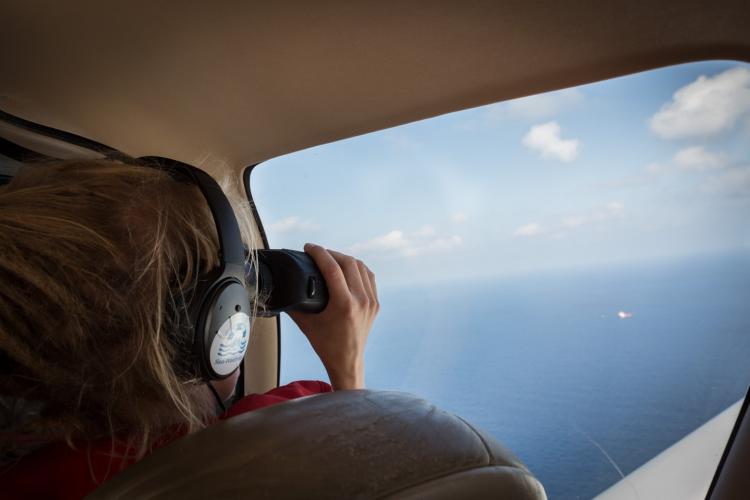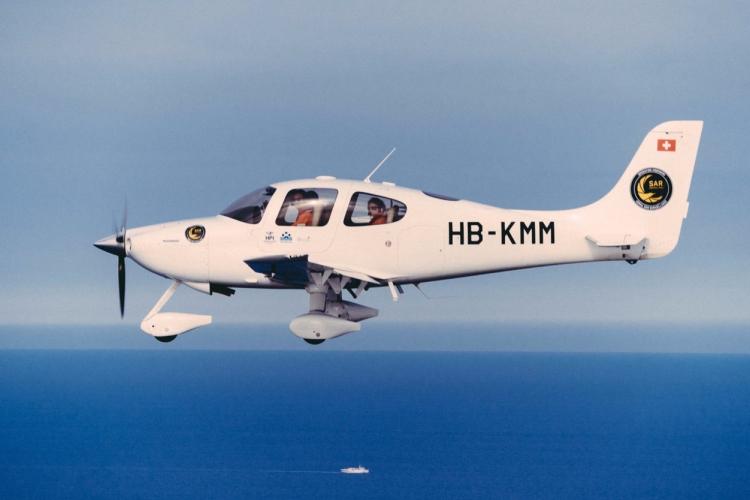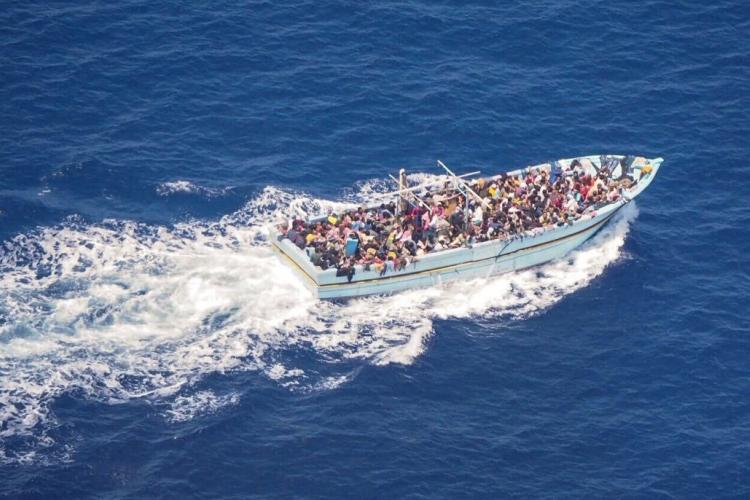Battles Over Migrant Rescue Take to the Skies with Civilian Counter-Surveillance
Posted:
Time to read:
Guest post by Angela Smith. Angela is a researcher of migration, political geography, colonialism and security practices in the North Africa region. She is undertaking interdisciplinary doctoral research at the University of New South Wales (UNSW) Sydney, examining the role of aviation and air power in deportation and border policing across the Mediterranean.

The crew of the civilian aircraft Moonbird circles above the central Mediterranean Sea, scanning the vast waters for any signs of boats in distress. From high above, the crew’s “spotters” learn to read the shifting detritus of the seascape – a bobbing petrol cannister or life jacket may suggest that a boat is in trouble in the area. The Moonbird is a single engine Cirrus SR22, the first plane operating under a joint civilian reconnaissance mission by the Swiss Humanitarian Pilots Initiative (HPI) and German NGO Sea-Watch since spring 2017. Through their aerial operations, these civil initiatives are able to both spot boats in distress to advocate for a rescue to be launched, and document violations against migrants and cases of non-assistance at sea.
Last year, the conflict in Libya created additional pressure for migrants wanting to leave the country via the central Mediterranean crossing. From January through to December 2020, the Moonbird undertook a total of 96 missions, spending a total of around 527 hours in the sky. Over the course of the year, the crew spotted around 4,493 persons in 82 boats in distress at sea, reporting these cases to the relevant authorities - usually the Italian, Maltese or Libyan Maritime Rescue Coordination Centres (MRCC) and advocating to ensure a timely and legal rescue was undertaken. In 19 of these cases, the boats were intercepted by the Libyan Coast Guard and the migrants were illegally returned to Libya. These are just some of the 11,265 people UNHCR reports were intercepted at sea and taken back to Libya in 2020.
The busy summer season of aerial missions came to a halt on 4 September 2020, when Sea-Watch announced that the Moonbird had been grounded by the Italian authorities, reportedly for spending too many flying hours surveilling the sea. For the Moonbird crew I interviewed, who consider themselves the “eyes” of civil rescue, this grounding was intended to prevent them from continuing in their role of witnessing and documenting European violations. The Italian authorities withdrew the grounding order on 25 October and the Moonbird is back in the skies this year. In February and March 2021 alone, they flew 23 missions and spotted around 2,820 people in distress in seven different boats.
Last year’s grounding was not the first time that the Moonbird has been prevented from flying. In the summer of 2018, the Moonbird was grounded for more than three months by Malta. The grounding came just days after EU leaders endorsed the approach of Italy’s new populist government with Matteo Salvini repeatedly condemning civilian rescue efforts in the central Mediterranean. In the summer of 2019, after moving its operations from Malta to Lampedusa, the Moonbird was grounded by Italy alongside another civil surveillance aircraft – the Colibri – operated by French NGO Pilotes Volontaires.
In addition to their rescue efforts, Moonbird uses their unique birds-eye position to hold European member states and agencies accountable for their actions at sea through campaigning, advocacy, and building court cases against European authorities. This year, Moonbird has witnessed and documented multiple failures of the Maltese authorities to protect and respect the rights of migrants and refugees at sea including: delayed or denied rescues, failure to provide assistance within its own Search and Rescue (SAR) zone, pushbacks from the Maltese SAR zone to Italian waters coordinated pushbacks to Libya, arbitrary detention of refugees and migrants at sea, and denial of a place of safety to disembark. These actions are variously in violation of international, refugee, human rights, and maritime law.
Since 2017, researchers and activists have documented an increasing level of collaboration, investment and reliance upon the Libyan Coast Guard to undertake interceptions at sea and conduct illegal returns to Libya, which is in the midst of a fierce conflict and routinely detains migrants in inhumane conditions. After creating a ‘rescue vacuum’ at sea, European authorities rely upon Libyan authorities to systematically undertake pullbacks. Since the Libyans do not have their own aircraft patrols, drones or radar equipment, the aerial information and coordination passed on from European aerial assets is crucial. By strengthening their aerial operations, European actors attempt to obscure and conceal their actions (and inactions) from the public view. Without civil aerial surveillance, it would be difficult to observe the role of the European aircraft in facilitating pullbacks, compared to when Europe was directly engaging in pushbacks at sea. With European vessels withdrawn from the water and NGO boats increasingly criminalised, the key visible actor left at sea engaged in interceptions is the Libyan Coast Guard.

One of the most striking pieces of evidence of this shift towards aerial forms of border control can be seen in the recent allocation of assets to EU naval operations in the Mediterranean. As its mandate wound up in March 2020, Operation Sophia listed its deployed assets as entirely made up of aircraft, and no ships. Its successor, Operation Irini, was launched with the purpose of enforcing the UN arms embargo on Libya, and currently has seven air assets and three ships assigned to it. Researchers have also documented EU aerial assets enlisting merchant ships to undertake privatised push-backs. As the European authorities have relied increasingly on aerial surveillance to facilitate various forms of illegal pushback, NGOs have responded in turn by also taking to the skies.
Having been involved in maritime Search and Rescue (SAR) operations since 2015, Sea-Watch recognised the need for an aerial perspective to identify boats in distress over a greater area. Without civil actors like Sea-Watch, Humanitarian Pilot’s Initiative and Pilotes Volontaires taking the ambitious and costly decision to launch aerial operations, many more deaths would have occurred at sea in this period. Civil actors operating in the skies also provide a form of aerial counter-surveillance to challenge the state’s monopoly over the aerial perspective being used to coordinate interceptions and pullbacks.

Civilian vessels at sea have faced similar struggles with European authorities since 2017 amidst the contested search and rescue politics of the central Mediterranean. Civil rescue at sea has become highly politicised and variously criminalised, with NGOs standing accused of both aiding and abetting irregular migration, and functioning as an incentivising “pull factor”. By the end of 2020, national authorities in Europe had initiated around 50 criminal and administrative proceedings against crew members or vessels, including seizing some vessels.
While the grounding of the Moonbird signals a vertical expansion of the criminalisation of civil rescue efforts from the sea to the skies, it also points to an important shift in European bordering practice. The skies are not only a new site for states to assert dominance over civilian actors engaged in search and rescue, but also a new tactic of bordering by European authorities which seeks to evade legal responsibility for illegal pushbacks. The landmark 2012 Hirsi judgement of the European Court of Human Rights ruled that pushbacks to Libya constitute refoulement and are a breach of international human rights law. The European authorities have created not only a rescue vacuum at sea but appear determined, through their distancing aerial bordering tactics, to operate within a legal vacuum from the skies, accountable to none.
Any comments about this post? Get in touch with us! Send us an email, or post a comment here or on Facebook. You can also tweet us.
__________
How to cite this blog post (Harvard style)
Smith, A. (2021). Battles Over Migrant Rescue Take to the Skies with Civilian Counter-Surveillance. Available at: https://www.law.ox.ac.uk/research-subject-groups/centre-criminology/centreborder-criminologies/blog/2021/06/battles-over [date]
Share:








